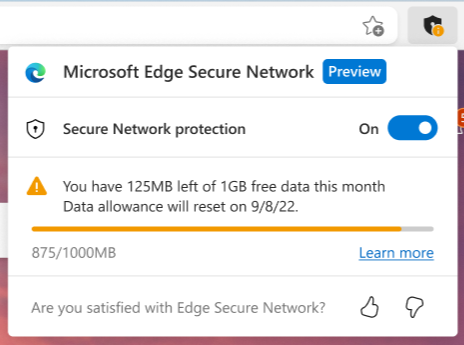
A VPN, virtual private network, is a great way to instantly improve your online security, but it often comes with a cost and additional downloads. This week, Microsoft has announced that it will add a VPN directly to its Chromium-based Edge browser.
In its latest attempt to bolster Edge’s value proposition, Microsoft has added this new VPN tool directly to the browser. The “Microsoft Secure Edge Network” is powered by Cloudflare. The feature appears largely similar to Cloudflare’s 1.1.1.1 service.
The advantage for users running this private network is enhanced online security, with your data largely protected from your ISP as well as hiding your location. Microsoft explains:
When using Microsoft Edge Secure network, your data is routed from Edge through an encrypted tunnel to create a secure connection, even when using a non-secure URL that starts with HTTP. This makes it harder for hackers to access your browsing data on a shared public Wi-Fi network.
By encrypting your web traffic directly from Microsoft Edge, we help prevent your internet service provider from collecting your browsing data like details about which websites you visit. Microsoft Edge Secure Network lets you browse with a virtual IP address that masks your IP and replaces your geolocation with a similar regional address to make it more difficult for online trackers to follow you as you browse.
For the time being, this VPN service is only in testing, rolling out to the Dev channel of Edge updates. To use the feature, you’ll need to be signed into a Microsoft account. Why? While this VPN is largely free, it does have a 1GB-per-month limit. Your data cap is tied to the Microsoft account, and purged by Cloudflare at the end of each month. Personally identifiable data is purged every 25 hours.


It’s unclear at this point exactly when Microsoft Edge will roll out this VPN integration, but the support page detailing the feature exhaustively hints that its arrival should be just around the corner.
While many features that arrive in Microsoft Edge eventually make their way to Google Chrome since both browsers share the same codebase, we suspect this one won’t make the cut. After all, this is a feature Microsoft specifically developed with its partner in Cloudflare. That said, it wouldn’t be particularly difficult for Google to do something similar, especially with its 8.8.8.8 service already being an internet staple.
More on Microsoft Edge:
- Microsoft Edge adds built-in ‘buy now, pay later’ service, turned on by default
- Microsoft Edge tries to stop you from downloading Google Chrome
- Microsoft Edge adds a handy Kids Mode in its latest move that Google Chrome should copy
Author: Ben Schoon
Source: 9TO5Google



